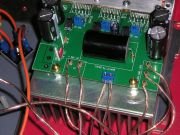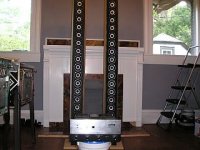Not really. They accept gauge 8 wire. Certainly as big as my speaker wire, and the own PCB connector pin. I didn't have anything bigger in my own stock. The other parts were expensive, so I tried to spare some cash by using my own stock connectors. They are very good heavy-duty Weidmuller industrial connectors
SB
SB
alexw88 said:Looks good! but would the speaker connector a bit small?
I should have been more specific when I asked you which connectors you used. I managed to get the right pitch but the pins are a tad loose. I'm guessing you used a higher amperage connector. Mine are rated for 25A (12awg) 🙁
i finally got two of the bpa150 boards assembled and adjusted the dc offset to 0.9mv,1mv. i was very pleased at how well they sounded. i am going to test the drv card today and hook the amps in btl. also, on bpa 150 runs a lot hotter than the other. i do know why put will check further. i can not seem to shrink the pictures to attach oh well
Yes they will run hotter than the single 3886. At normal listen volume, mine is warm, but not very hot. When I test them at 300W, they became very hot.
How big is your heatsink?
How big is your heatsink?
Hi,
the 3886 quotes 50mA typical and 85mA max for Iq.
I don't have any data for min Iq.
This alone can account for significant differences in operating temperature.
However, an adequately sized heatsink should make Iq's effect on Tc so small to be insignificant.
Or,
could an assembly fault be causing one or more chips to become unstable?
the 3886 quotes 50mA typical and 85mA max for Iq.
I don't have any data for min Iq.
This alone can account for significant differences in operating temperature.
However, an adequately sized heatsink should make Iq's effect on Tc so small to be insignificant.
Or,
could an assembly fault be causing one or more chips to become unstable?
alex88, the heatsink is the same size as the ones you used but twice as deep, ie 3.5 inches deep. i am touching the actual chip to feel the temperature and like i said before all three chips on one sink are very hot and on the other just warm. if i isolate the sink from the chassis could i mount the three chips directly to the sink. or do they need to be isolated from each other. alex, you did a great job with this layout. i was surprised at the depth and extension of the bass and only using one bpa150. looking forward to bridging today and testing. what is a realistic dc offset figure to shoot for. if you design a nice high power discrete amp please let me in on buying a few pcb's. any hints on how to shrink pictures so i can post on the forum.
andrew t, i am going to go back and check a few things today. the noise from my speakers was dead silent with everything connected. so i do not think it is a short because i had no hum or white noise. i checked all of the resistors before installation to verify values. it might be a simple situation of poor sink contact.
i was reading an earlier post by you where you mentioned several different grounds in an amp ie, earth, common, equipment etc. many of my early mcintosh amps only have two prong plugs with no earth ground as does most of the plugs in my 100 year old house. aside from electrocution protection what would be wrong with running my amp without earth ground , which i am doing while testing since my variac only has two prong plug. also could not a ground to earth be utilized by attaching to a copper rod driven into the ground and connected to the chassis thanks
i was reading an earlier post by you where you mentioned several different grounds in an amp ie, earth, common, equipment etc. many of my early mcintosh amps only have two prong plugs with no earth ground as does most of the plugs in my 100 year old house. aside from electrocution protection what would be wrong with running my amp without earth ground , which i am doing while testing since my variac only has two prong plug. also could not a ground to earth be utilized by attaching to a copper rod driven into the ground and connected to the chassis thanks
I think the 3886's metal is connected to the -ve power rail. I would isolate them from the heat sink for safty purpose. You can easily short something to the heat sink by accidient.
The best DC offset I get is 9mV, you are now at 1mV which is very good already. I think that depends on chips. If both PCBs has the same DC offset, after you bridge the 2 boards, the DC offset at speaker terminal should be 0.
I used photoshop to re-size pictures, but any photo editor should do.
The best DC offset I get is 9mV, you are now at 1mV which is very good already. I think that depends on chips. If both PCBs has the same DC offset, after you bridge the 2 boards, the DC offset at speaker terminal should be 0.
I used photoshop to re-size pictures, but any photo editor should do.
andrew i have the file in irfanview and it will not compress below 105k for this forum. i might have to work with it. i started using irfanview after downloading stuff from one electron some months ago. it is a useful tool.
Hi,
is that what might be called a long line array?
Can we assume the steps are to get your ears up to the optimum height?
is that what might be called a long line array?
Can we assume the steps are to get your ears up to the optimum height?
i sit on a ladder when i listen to music --- does not everyone. roger russel original design was 5 drivers taller -- go figure!!! they sound pretty good. just something to do, have to stay busy or i will get old. now i am trying to find the hum in my bpa 300. it sounded perfect before i tied the two boards together. extra gain i suppose.
Nice speakers!
When I bridge the PCBs I also get hum in my first try. It turns out to be the wiring method created ground loop.
The red drawings indicates my hum wiring

Try using shorter and twisted wires, placing the boards closer together, and to avoid any visible wire "loops".
In my current wiring setting, the amp is dead silent.
When I bridge the PCBs I also get hum in my first try. It turns out to be the wiring method created ground loop.
The red drawings indicates my hum wiring

Try using shorter and twisted wires, placing the boards closer together, and to avoid any visible wire "loops".
In my current wiring setting, the amp is dead silent.
alex, you also said on the website that your transformer was dead silent without even a little hum. can small amounts of transformer hum find there way to the speakers.
I don't think it can... Before you bridge you don't have hum in the speaker so it shoudl not be the transformer.
Can you show a picture of your bridged amp?
Can you show a picture of your bridged amp?
has anyone had any luck connectin the s`ingle ended leads directly to pcb for bridge operation. i connected the ground to one + input the the positive to the other + input. my amps sound fantastic with only the cd player driving them. i have a balanced sound card on my computer and will try it next. how is the transformer project going alex
hum in amp
i finally got rid of all the noise from the amp. nothing but music. sounds nice. now to the other monoblock.
i finally got rid of all the noise from the amp. nothing but music. sounds nice. now to the other monoblock.
- Status
- Not open for further replies.
- Home
- Group Buys
- BPA300 mono block

